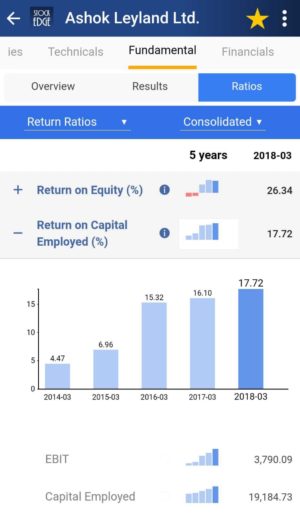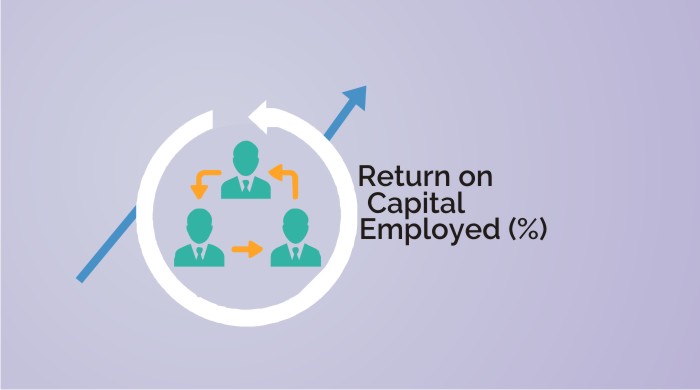Table of Contents
Financial ratios are important parameters that help investors to decide on their investment. We will discuss the impact of Return on Capital Employed. Any ratios are important in their own manner for a different kind of financial analysis. A financial ratio is a representation of selected numerical values from a company’s financial statements. Financial ratios help in deciding the valuation strength of the company. There are a lot of ratios such as PE Ratio, Net profit margin, interest coverage ratio, etc. used for valuation analysis of a company.
Return on Capital Employed measures how efficiently a company can generate profits from its capital employed by comparing net operating profit to capital employed. In other words, return on capital employed shows investors how many rupees in profits each rupee of capital employed generates.
What is Return on Capital Employed?
Return on capital employed (ROCE) is a financial ratio that can be used in assessing a company’s profitability and capital efficiency. The ROCE ratio is one of several profitability ratios financial managers, stakeholders, and potential investors may use when analyzing a company for investment.
You can also watch the below video on Everything you want to know about Return on Capital Employed (ROCE):
Impact of Return on Capital Employed
ROCE is a long-term profitability ratio because it shows how effectively assets are performing while taking into consideration long-term financing. This is why ROCE is a more useful ratio than the return on equity to evaluate the longevity of a company. ROCE can be especially useful when comparing the performance of companies in capital-intensive sectors, such as utilities and telecoms. This is because unlike other fundamentals such as return on equity (ROE), which only analyzes profitability related to a company’s shareholders’ equity, ROCE considers debt and equity. This can help neutralize financial performance analysis for companies with significant debt.
Exceptions
The ROCE of a company varies from industry to industry. This is a good indicator if we are comparing companies in the same sector else it will show diverging results.
Return on Capital Employed Formula
ROCE= EBIT / Capital Employed.
- Earnings before interest and tax (EBIT) is the company’s profit, including all expenses except interest and tax expenses.
- Capital employed is the total amount of equity invested in a business. Capital employed is commonly calculated as either total assets less current liabilities or fixed assets plus working capital.
Suppose a company generates revenues of 8 crores and its expense is 5 crores and the depreciation shown in its books is 1 crore then EBIT is (8-5)-1=2 crores, its capital employed is 5 crores, in that case, ROCE= 2/5=40%. EBIT is earnings before deduction of Interest or Tax but after deduction of expenses and depreciation.
See also: Price to Earnings Ratio (PE Ratio)
StockEdge App
Nowadays we don’t have to calculate RoCE on our own. StockEdge gives us RoCE of the last year of any company listed in the stock exchange. We can look and compare the RoCE of any company and filter out stocks accordingly.
Suppose we want to look at the RoCE of Ashok Leyland of last year. In the Fundamental tab of Ashok Leyland, click on the fundamentals tab, we will get the ratios tab. Then in the Ratios tab click on Return Ratios, and we get the RoCE in a fraction of seconds.

What is a good return on capital employed?
A good ROCE should be equal to at least twice current interest rates. However, there are no firm benchmarks.
Can ROCE be negative?
Yes, ROCE can be negative. A negative ROCE implies negative profitability, or a net operating loss.
What does ROCE mean?
Return on capital employed (ROCE) is a financial ratio that is used in assessing a company’s profitability and capital efficiency. It helps to understand how well a company is generating profits from its capital. The ROCE ratio is one of several profitability ratios used when analyzing a company for investment by investors and fund managers.
What is a good percentage for ROCE?
A good ROCE should be equal to at least twice current interest rates. However, there are no firm benchmarks.
Bottomline
Return on capital employed is an important parameter to measure how efficiently a company utilizes its working capital to generate better returns. These ratios are freely available in the StockEdge app, with every stock. We also have scans based on RoCE, with the help of these ready-made scans you can with the click of a button filter out good companies. So what are you waiting for? If you still do not have the StockEdge app, download it right now to use this feature. It is a part of the premium offering of the StockEdge App.
Join StockEdge Club to get more such Stock Insights. Click to know more!
You can check out the desktop version of StockEdge.










